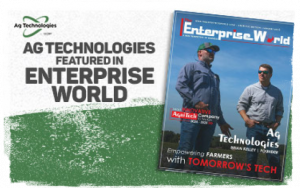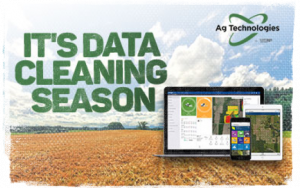The Evolution of Precision Agriculture
The agricultural industry has been on a path to autonomy for decades, though many farmers may not have realized it. From the first precision agriculture systems to today’s fully autonomous equipment, each innovation has been a stepping stone toward smarter, more efficient farming operations.
“We’ve been on this path to autonomy since precision agriculture came on the scene,” explains Brian Kelley, Agricultural Technology Specialist at AgTechnologies. “From the first sensors we started putting on machines to control spreaders and sprayers, to getting to where we could do variable rate applications—it was all building blocks towards autonomous applications happening in the coming years.”
This gradual evolution is now accelerating as labor shortages, economic pressures, and technological advancements converge to create both challenges and opportunities for modern farmers.
Beyond Self-Driving Tractors
When most people think of agricultural autonomy, they imagine tractors driving themselves across fields without operators. However, as Kelley points out, that’s actually the simplest part of the equation.
“Self-driving tractors is the easiest part of autonomy. Driving the tractor is the easiest part,” Kelley explains. “It’s all the controls behind the machine, understanding what we’re doing. Are we lifting the implement at the right time? Are we applying the right amount of materials? Are we going too fast or too slow to make sure we’re getting proper agronomic results?”
True autonomy encompasses the entire operation—not just steering, but also implementing control, application rates, and agronomic decision-making. The technology that enables a tractor to navigate a field is just one component of a comprehensive autonomous system.
“What auto-steer enabled farmers and operators to do was look back and focus more on what they were doing behind the machine,” Kelley notes. “Now we’re literally saying we’re going to take you out of the cab completely, and that opens up a whole other set of things we need to control.”
Solving the Labor Challenge
One of the most pressing issues facing agriculture today is the ongoing labor shortage. As other industries compete for workers with higher wages and different working conditions, farms are finding it increasingly difficult to attract and retain qualified labor.
“We’ve educated our country beyond the willingness to work at a farm labor job,” Kelley observes. “We’ve lost good people from the farm because other industries are looking for good people who will work hard.”
This reality is pushing many farm operations to consider autonomous solutions not as a way to eliminate jobs, but as a means to optimize their existing workforce.
“How do we take people with higher education or more capabilities and give them more opportunity so they can run multiple tractors?” Kelley asks. “Autonomy begins to do that. It’s a force multiplier. You can take a person that’s higher paid, that didn’t want to just drive a singular tractor, and scale them.”
Rather than replacing workers, autonomy allows farms to utilize skilled labor more effectively. One person can monitor and manage several autonomous machines simultaneously, focusing on higher-level decision making rather than the repetitive task of driving.
Breaking the Traditional Equipment Equation
Autonomy is fundamentally changing the economics of farm equipment. For decades, manufacturers have built increasingly larger tractors because having one person operate a bigger machine was the only way to increase efficiency. Autonomy breaks this equation.
“If you think about what John Deere and all the other majors have done, they had this equation that included a person plus the size of a machine to equal so many acres per day,” Kelley explains. “Well, now we eliminate one of those variables. We literally break the math. We break the equation for the industry.”
This disruption opens up new possibilities. Instead of continually increasing horsepower, farms might shift toward multiple smaller autonomous machines working in coordination. The implications for equipment design, farm operations, and economics are profound.
“We’ve been going to bigger tractors because we had this single point of scale, and that was a person,” says Kelley. “If we break that equation, we don’t know where the industry goes after this with full-fledged autonomy adoption.”
The Unexpected Benefits of Autonomy
While labor savings and operational efficiency are the most obvious advantages of autonomous systems, early adopters have discovered additional benefits that weren’t initially anticipated.
“A lot of our farms have found that they grossly underestimated what kind of agronomic benefits they were going to get,” Kelley shares. “Staying on a mowing plan, for example, has extreme agronomic benefits that they didn’t fully appreciate until implementing autonomous systems.”
Maintenance costs have also decreased significantly. “One farmer gave a testimonial about how autonomy and having consistency with the operation of his tractor and mower reduced his maintenance on his implements,” Kelley recounts. “It reduced it by 60-something percent. He was losing rollers on his mowers and having to replace bearings, and now he’s not having that issue anymore.”
Productivity gains have been substantial as well. “They’re getting across 35% more acres in a day’s time,” Kelley notes. “Some have said it’s even more than that, but I think that’s a conservative number.”
The Sabanto Approach: Retrofitting Existing Equipment
While some manufacturers are developing autonomous machines from the ground up, Sabanto—a company that AgTechnologies has partnered with—takes a different approach by retrofitting existing tractors with autonomous capabilities.
“We chose to go the Sabanto route for a lot of reasons,” Kelley explains. “We look at any technology’s runway, where they are in their funding, and their long-term aspirations.”
The Sabanto system transforms conventional tractors into autonomous workhorses, enabling farms to leverage their existing equipment investments while gaining the benefits of autonomy. Once installed, the system’s advanced cameras, obstacle detection sensors, GNSS systems, and robotics pair with intuitive control applications to provide complete operational oversight.
“Craig Rupp, the CEO of Sabanto, wanted to have a good enough product to get to market and then let the market help develop the rest,” Kelley says. “I really like that approach. I think that’s a unique engineering approach that a lot of companies originally got started with and have gotten away from.”
This collaborative development process has allowed Sabanto to refine their technology based on real-world feedback, ensuring that it addresses the actual needs of farmers rather than what engineers think farmers might need.
Who’s Ready for Autonomy?
While autonomy will eventually benefit all farms, not every operation is ready for it today. The best candidates are those who have already adopted precision agriculture technologies and are willing to embrace change.
“I believe the technology is for all farms, but maybe not today,” Kelley clarifies. “It will ultimately be for all farms, whether it be Sabanto or some version of it. How I define who’s ready is where they are in their precision ag adoption cycles.”
Early adopters tend to have a longer-term perspective on their operations. “Our early adopters are usually living two to three to five years out in their businesses,” Kelley observes. “They’re seeing something hard coming for their business, and we need to change today to be ready for it.”
Unfortunately, economic pressures prevent many farms from taking this long view. “A lot of our farms have been kept so tight that they’re having to look at what they’re doing next week, next month, or just this year—not even able to plan multi-year, which is an unfortunate state of where our farming industry is,” Kelley laments.
From Turf to Row Crops: The Expanding Applications
AgTechnologies and Sabanto initially focused on the turf industry for autonomous applications, but the technology has potential across all agricultural sectors.
“We focused on the turf industry because they have high repetition activities, such as mowing, throughout the year in a very controlled crop environment,” Kelley explains. “We knew those were going to be necessary components for autonomy to be successful.”
This strategic approach allowed the technology to prove itself in a relatively controlled environment before taking on the greater complexity of row crops and specialty agriculture. The same principles, however, apply across farming operations.
“Every farm, whether it be turf, celery, caladiums, sugar cane, cotton, peanuts, corn, beans—the list goes on—all have a need for some autonomous application,” Kelley asserts. “Whether it’s tillage because they need to reduce horsepower and go to a smaller machine that burns less fuel, or just reducing labor issues, autonomy opens up new possibilities.”
The Future of Agricultural Autonomy
Looking ahead, Kelley believes that autonomy will continue to transform farming in ways we might not yet fully comprehend.
“The first time I saw an auto-steer work, I was just wowed and floored by what it was capable of doing,” he recalls. “And with autonomy, as we scratch the surface, which is all we’re doing right now, I am confident I am underestimating what benefits and farming practices are going to be unlocked.”
The path forward involves continued refinement and expansion of autonomous capabilities. “I believe we continue to chip away day by day, week by week, month by month, year by year, at the application controls behind the machine and the different crop types,” Kelley predicts.
This evolution will likely face resistance from traditional equipment manufacturers as they grapple with the disruption to their business models. Nevertheless, Kelley sees autonomy as inevitable, driven by economic necessity and technological progress.
“I believe it could actually have such a financial shake-up in the industry of farming that I don’t think we as an industry would be prepared for the type of shock it could have on everything from tractor values, machine values, all the way through to farming practices,” he concludes.
The Integration Advantage
Technology alone is never enough—successful implementation requires expertise and support. AgTechnologies has built its reputation on understanding both the technology and the farming operations it serves.
“Part of our job is creating an environment which enables our farmers, our clients, to confidently adopt sophisticated technology tools,” Kelley emphasizes. “Technology might be capable of doing it, but the person that just sold it and left didn’t understand what they were doing and misled the customer, whether intentionally or not.”
This integration expertise is particularly critical with autonomous systems, which represent a significant shift in how farms operate. AgTechnologies combines Sabanto’s cutting-edge technology with deep agricultural knowledge to ensure successful implementation.
“Ag Technology has been successful with the early adoption of new innovations because we understood the farm, we understood the problem, and we went and looked for the tools to solve those problems,” Kelley states. “Those tools were not just a piece of technology, a GPS receiver, or a control box. It was the people that go along with it that understand the problem, understand the farm, and help them integrate those tech tools.”
As agriculture continues to evolve, autonomy represents both a challenge and an opportunity. For farms willing to embrace change and look to the future, autonomous technology offers a pathway to greater efficiency, productivity, and sustainability. The journey toward full autonomy may be gradual, but as Brian Kelley suggests, we may only be scratching the surface of what’s possible.
Ready to explore how autonomy can transform your operation? Contact AgTechnologies to start your journey toward the future of farming.






